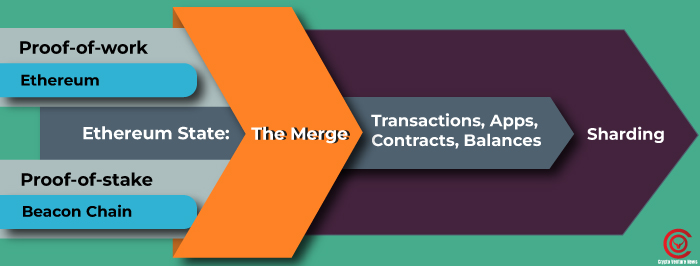Update: The Ethereum Merge to form Ethereum 2.0 or ETH 2.0 (ETH2) has been completed on the 15th of September, 2022 at around 2:43 am EST. The Mainnet merge consisted of the Bellatrix upgrade and Beacon Chain integration. The Ethereum merge testnet that is the Goerli testnet merge had already been conducted on the 10th of August, 2022.
The merge might have saved the Ethereum ecosystem from constant crashes. However, the recent performance of ETHPoW (ETHW) shows that it failed in doing so.
A massive new structure has been built alongside Ethereum (ETH). The core of the said structure is the Beacon Chain that reforms the consensus model from the Proof of Work (PoW) to the Proof of Stake (PoS). This stated Beacon Chain is the heart of the second generation of Ethereum. It is the base on which the rest of the components such as eWasm, Shard, and cross-link will be built. The PoS-based chain will run in parallel times with the mainnet or the PoW-based chain. The chain is mainly made for the validators.
The Beacon Chain launch took place back on December 1, 2020, as a part of the Ethereum 2.0 Serenity Upgrade. This upgrade possesses several phases in which the last one is phase 2.
What Is The Beacon Chain?
The Beacon Chain is a part of Ethereum 2.0 upgradation and stands at phase 0. The zero phase basically aims at the participation of the validators that will be serving as the foundation for the development of future phases. At the zero phase, the users can register as validators by staking only 32 ETH. Additionally, there is also an Ethereum Beacon Chain staking pool where a number of users can combine their Ethers to make up 32 ETH.
The crypto validators are incentivized with staking rewards and transaction fees. Nevertheless, the returns from the staking rely on the amount of the staked ETH in the system where the users can grab an opportunity to receive more returns by staking even more Ethereum. The Beacon Chain Token ticker is BECN.
What Is The Work Of The Validators On The Beacon Chain?
As already mentioned, the users would be required to stake their 32 ETH to the mainnet smart contract of Ethereum for being qualified validators on the Beacon Chain. The staked Ethereum is then locked and the smart contract generates a Merkle hash. It is a kind of mechanism that proves the ownership of the ETH stake by preserving a record of the validator’s entry.
Being a decentralized network that is soon going to adopt the proof of stake (PoS) protocol, Ethereum 2.0 plans to have a minimum of 16,000 validators for the Beacon Chain. Currently, there are two kinds of validators such as a proposer and an attestor.
- Proposer: A proposer creates blocks and earns rewards when the attesters vote for the proposer’s selected blocks. When the blocks fail to be created within the 12-second time frame, the proposer misses their reward. Sometimes the validators also do not do their jobs as they are offline.
- Attestor: The work of an attestor is to ensure the validity of the blocks via voting. An attestor will never vote for an invalid transaction that a proposer might have selected. In addition to this, the attestor can also report the proposer for proposing invalid transactions. This results in a slashing penalty.
In spite of the rewards, the users might have to face some risks that the Beacon Chain presents. For instance, the staked ETH is locked on this chain until phase 1.5 which is expected to arrive by the first quarter of 2022.
On top of this, the validators are prevented from acting against the system’s interest via slashing. Slashing refers to the fact that the validators might lose some of their staked ETH as a means of punishment for serious malicious behaviors. This method has been established in the bid to non-controlling 51% of the validators and commits a 51% of the ETH stake on the blockchain.
What is more is that if a number of the validators happen to commit a slashable behavior at the same time, they are supposed to lose all of their staked Ether. The validators might also be lucky enough to receive the whistleblower rewards or incentives by reporting the other validators for slashable behavior. In the initial phase or phase 0, the whistleblower incentives are primarily distributed to the proposers for recording the evidence of slashing within a block.
Furthermore, the validators bearing less than 16 ETH stakes will be taken off the Beacon Chain and thus can no longer participate in the validating process. This practice is also the way the Beacon Chain keeps its validator working honorably. The Beacon Chain also imposes another penalty for the inactive validators known as the quadratic leak. In the blockchain, all the epochs consist of 32 slots.
The validators possess one slot for adding blocks and shards every 12 seconds to the Beacon Chain. A quadratic leak occurs when a validator is inactive or offline, quite frequently missing nearly 8000 epoch slots for the Beacon Chain. The staked Ether for these validators following this will be reduced partially.
What Is The Work Of The Beacon Chain?
The Beacon Chain primarily stores data such as the validator addresses, shard links, and validator states. It also enables the validators to work in groups for proposing, voting for the blocks, and reporting the slashable behavior of the other validators. Apart from this, some of the other tasks that the Beacon Chain takes up for phase 0 are:
- Validators & Staked Ether: The Beacon Chain oversees the validators and as well as manages the staked Ether.
- Validator Committee: The chain forms each of the communities with the minimum 128 validators. A committee in this respect is a group of random validators performing votes recorded on the Beacon Chain and also oversees the behaviors of the proposers. The blockchain randomly chooses the validators for reducing the risks of the malicious attacks.
- Consensus: The Beacon Chain enforces the rules for the PoS protocol on its chain and on all the shard chains in the future phase 2 on the Ethereum 2.0.
How Is The Beacon Chain Different From Ethereum 1.0?
At phase 0, the Beacon Chain did not possess EVM or Ethereum Virtual Machine components and the smart contracts as the following phases had not been implemented. The chain mainly introduced the PoS consensus. In the meantime, Ethereum 1.0 uses the proof of work mechanism. In phase zero, both the blockchains run separately for ensuring data continuity. Nevertheless, it is expected that the future Ethereum upgrade will completely convert it to the PoS consensus model of the Beacon Chain that will bring in several benefits such as:
- Minting
The proof of work creates blocks when their hardware processes the blockchain transactions. The more hardware they possess, the more blocks can be created. The proof of stake makes use of several validators for vouching for the validity of the transaction prior to the block creation. One of the validators gets activated when 32 ETH gets deposited. Thus, the users can control one validator in case they fulfill the balance of the Ethers required for each validator activation.
- Resources
The proof of work utilizes huge amounts of electricity for verifying transactions. On the contrary, the PoS is much more environment-friendly than the PoW as a user’s mining power is attributed to the number of Ether a user possesses. Therefore, a user who bears 5% of the tokens of a PoS network can solely mine 5% of the blocks and thus there is no requirement for excessive energy usage.
The rewards for a PoS user also will be reflected in their staked ETH. For instance, the users who own 5% of the staked Ether will receive 5% of the reward from the created block.
- Scalability
As the PoS is much more lightweight than the PoW, Ethereum 2.0 can very easily scale with this consensus model thus benefiting several projects that are built on the Ethereum blockchain. If the Ethereum 2.0 upgrade becomes successful, the chains might process up to 10,000 transactions per second or TPS. On Ethereum 1.0, the blockchain solely does 30 TPS which slows down the operation and causes the network to be congested.
- Speed
On the Proof of Work consensus, the fastest miner that can solve the equation for the block creation receives rewards. On the Proof of Stake, the system bears a predetermined slot of 12 seconds for the validators or the random virtual miners for validating the transaction. The validators will miss the reward if they do not create enough blocks in time after the Ethereum 2.0 Beacon Chain integration.
What Resides In The Future Of The Beacon Chain?
Sharding greatly affects the development direction of the Beacon Chain. It will be introduced in 2022 and will make the Ethereum Network perform more efficiently. It splits a single blockchain into numerous blockchains called shards. In the upcoming phases, the validators in the Beacon Chain block will be held responsible for maintaining the shards that they are assigned to randomly. On top of these, the validators will also oversee the shards including the states or the status of the blockchain and the transaction history. Owing to this, the validators on the Beacon Chain will be capable of communicating with the shards in the future.

For phase 1, the validators will also accumulate incentives for crosslinking transactions. The crosslink synchronizes the states between the Shard chain and the blocks on the Beacon Chain. Thus, the finalized Beacon Blocks will also represent the finalized shard blocks and will be facilitating the cross-shard transactions.
Usually, security is a major concern with a new upgrade for an ecosystem. A blockchain expert has also mentioned that low participation of staking is likely to cause the vulnerability to the network security. Nevertheless, the Ethereum developers had also expressed that the attacks might be quite expensive and will take around $100 million at a participation rate of nearly 99%.
There is also an opportunity that the security might be boosted as Ethereum plans to bear over 16,000 validators for the Proof of Stake consensus and the transaction validation. The extremely huge number of the validators also refers to the high decentralization and security for Ethereum 2.0.
The Closure
The Beacon Chain is the phase 0 of the Ethereum 2.0 Serenity Upgrade. Mainnet Beaconscan is the Beacon Chain Explorer on phase 0 of ETH 2.0. The phase solely focuses on the validator participation for the transaction validation. The users can also go ahead and become a validator by staking 32 ETH and they can also become more than one validator owing to the fact that they possess enough ETH. The validators are incentivized for creating blocks and voting for the valid transactions.
Nevertheless, there are some risks as the users are not permitted to withdraw their ETH till the commencement of phase 1.5. The validators might also lose their staked ETH permanently owing to inactivity or selecting the invalid transactions.
As of now, the Ethereum 1.0 and the Beacon Chain are operating parallely and separately until the Ethereum 1.0 completely merges with the chain making Beacon Chain merge true converting to the PoS consensus protocol and becoming Ethereum 2.0.
The Ethereum Beacon Chain introduces several benefits as the PoS consensus is much more environment friendly, decentralized and secure. Ethereum plans to bear a high number of the validators on the Beacon Chain bringing down the possibility of attacks and increasing the efficiency of the transactions.
- Bitcoin DCA: A Beginner’s Guide To Make Your Investments Easy - 29/03/2025
- 6 Most Funny Bitcoin Stories You Will Ever Know - 29/03/2025
- Easy Definition And Uses Of Crypto Regulatory Sandbox - 03/08/2024
 Crypto Venture News One stop Crypto Track Down
Crypto Venture News One stop Crypto Track Down 





